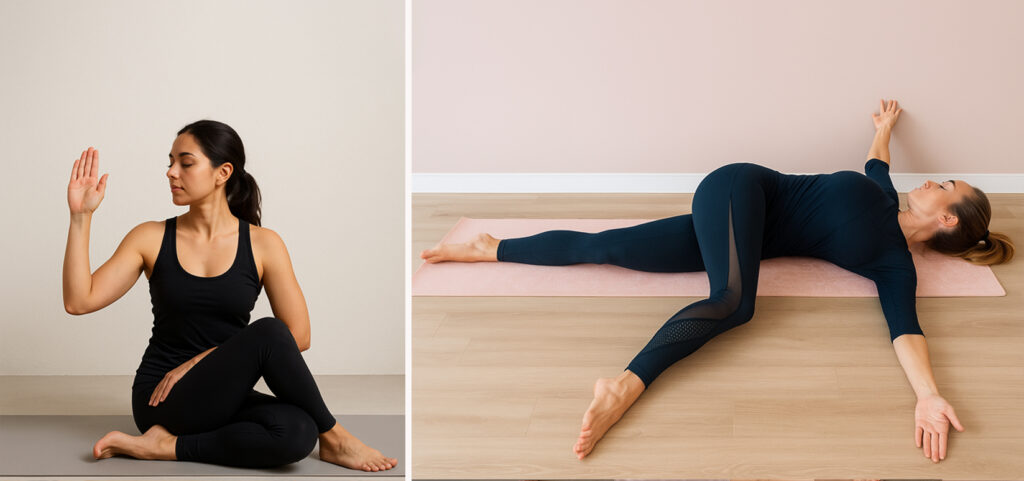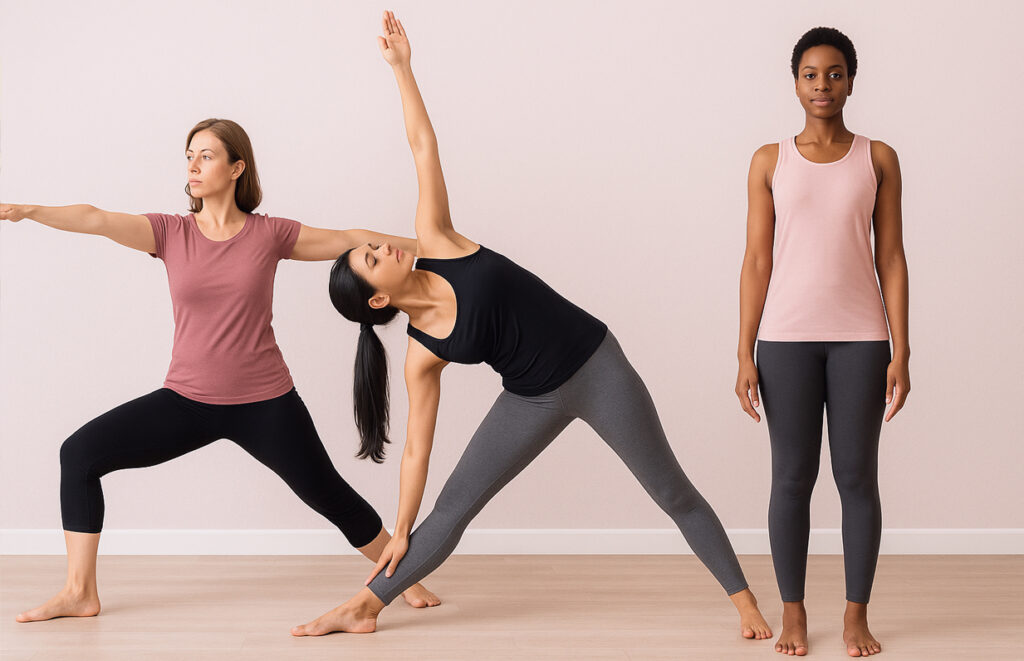Poor blood circulation can cause cold hands and feet, numbness, fatigue, and swelling. When blood doesn’t flow properly through your body, your tissues don’t get enough oxygen and nutrients. Yoga offers a gentle, accessible way to improve circulation through movement, breathing, and relaxation techniques.
Table of Contents
How Yoga Improves Blood Circulation
Yoga combines physical postures, breathing exercises, and relaxation techniques that work together to enhance blood flow throughout your body. The gentle movements and stretches help pump blood through your vessels, while deep breathing increases oxygen delivery to your tissues.
Physical Benefits
Yoga postures can increase blood flow to specific areas of your body. When you move through different poses, you alternately compress and release blood vessels, which helps improve circulation. Inverted poses, where your legs are elevated above your heart, use gravity to help blood flow back from your extremities.
Research shows that yoga may help improve brain blood flow in people with diabetes. A study found that 14 days of diabetes-specific yoga intervention showed trends toward increased blood flow velocity in the brain (1).
Breathing and Circulation
Deep breathing exercises (pranayama) are a key part of yoga practice. These breathing techniques can affect your circulatory system in several ways. Slow, deep breathing helps activate your parasympathetic nervous system, which can dilate blood vessels and improve blood flow. A systematic review found that slow breathing techniques enhance parasympathetic activity and are linked to emotional control and psychological well-being (2).
Stress Reduction Effects
Chronic stress can constrict blood vessels and reduce circulation. Yoga’s relaxation and meditation components help reduce stress hormones that can negatively impact blood flow. Regular practice may help your blood vessels function better by reducing this stress-related constriction. Research shows that mental stress causes peripheral vasoconstriction, which can reduce blood flow to vital organs (3).
Best Yoga Poses for Circulation
Certain yoga poses are particularly beneficial for improving blood flow. Here are some effective poses organized by their primary circulation benefits.
Inversion Poses
Inversions help blood flow from your legs back to your heart. Even gentle inversions can be beneficial:

- Legs-Up-The-Wall Pose (Viparita Karani): Lie on your back with legs extended up a wall. This gentle inversion helps blood flow from your legs without strain.
- Shoulder Stand (Salamba Sarvangasana): A more advanced inversion that reverses blood flow. Only practice this with proper instruction.
- Standing Forward Fold (Uttanasana): Bend forward from your hips, letting your head hang. This mild inversion increases blood flow to your brain.
Twisting Poses
Twists compress and release blood vessels in your torso, which can improve circulation to your organs:

- Seated Spinal Twist (Ardha Matsyendrasana): Sit with one leg crossed over the other, twisting your torso. Hold each side for several breaths.
- Supine Twist (Supta Matsyendrasana): Lie on your back and gently twist your knees to one side. This gentle twist is accessible for most people.
Standing Poses
Standing poses engage large muscle groups, which helps pump blood through your body:

- Warrior II (Virabhadrasana II): This wide-legged stance with arms extended works your leg muscles and improves lower body circulation.
- Triangle Pose (Trikonasana): Stretches and strengthens legs while the side bend helps circulation through your torso.
- Mountain Pose (Tadasana): Though it looks simple, standing with proper alignment engages muscles throughout your body.
Breathing Exercises for Better Blood Flow
Pranayama (breathing exercises) can be practiced separately or incorporated into your yoga routine. These techniques may enhance circulation through various mechanisms.
Deep Belly Breathing
Also called diaphragmatic breathing, this technique helps improve oxygen delivery throughout your body:
- Sit comfortably or lie on your back
- Place one hand on your chest and one on your belly
- Breathe in slowly through your nose, letting your belly expand
- Exhale slowly through your mouth, letting your belly fall
- Practice for 5-10 minutes daily
Alternate Nostril Breathing (Nadi Shodhana)
This balancing breath technique may help regulate blood flow:
- Sit comfortably with your spine straight
- Use your thumb to close your right nostril
- Inhale through your left nostril
- Close your left nostril with your ring finger, release your thumb
- Exhale through your right nostril
- Continue alternating for 5-10 rounds
Creating a Yoga Routine for Circulation
A well-designed yoga practice for circulation should include a variety of poses and breathing exercises. Here’s how to structure an effective routine.
Warm-Up (5-10 minutes)
Start with gentle movements to prepare your body:
- Neck and shoulder rolls
- Cat-Cow stretches
- Gentle seated twists
- Deep breathing exercises
Main Practice (20-30 minutes)
Include a mix of standing poses, inversions, and twists:
- Begin with standing poses to warm up large muscle groups
- Move to gentle inversions like Legs-Up-The-Wall
- Include twisting poses for organ circulation
- Hold each pose for 5-10 breaths
Cool-Down (5-10 minutes)
End with relaxation to maximize circulation benefits:
- Gentle stretches
- Restorative poses
- Final relaxation (Savasana)
- Breathing exercises
Modifications for Different Needs
Yoga can be adapted for various fitness levels and physical limitations. Here are modifications to make your practice safer and more effective.
For Beginners
If you’re new to yoga:
- Start with basic poses and shorter hold times
- Use props like blocks, straps, and blankets for support
- Focus on proper breathing before advancing to complex poses
- Consider taking a beginner’s class or using guided videos
For Limited Mobility
Chair yoga can provide circulation benefits for those with mobility issues:
- Seated twists and forward folds
- Ankle pumps and leg lifts
- Arm circles and shoulder rolls
- Modified breathing exercises
For Specific Circulation Issues
Different circulation problems may benefit from specific approaches:
- Cold hands and feet: Focus on poses that move blood to extremities, like arm and leg movements
- Leg swelling: Emphasize inversions and leg elevation poses
- Poor upper body circulation: Include arm balances and upper body stretches
Safety Considerations
While yoga is generally safe, certain precautions are important when practicing for circulation improvement.
When to Avoid Inversions
Some people should avoid or modify inverted poses:
- Those with uncontrolled high blood pressure
- People with glaucoma or detached retina
- During menstruation (optional, based on comfort)
- If you have neck or back injuries
Research has shown that inversion yoga poses can significantly increase intraocular pressure, which is contraindicated for people with glaucoma (5).
Medical Conditions
Consult your healthcare provider before starting yoga if you have:
- Heart disease
- Blood clotting disorders
- Severe varicose veins
- Recent surgery
Research indicates that combining yoga poses with blood flow restriction should be done carefully. A study found that yoga with blood flow restriction didn’t cause additional cardiovascular stress compared to yoga alone (6).
Combining Yoga with Other Circulation Strategies
Yoga works best as part of a comprehensive approach to improving circulation. Here are complementary strategies to enhance your results.
Regular Physical Activity
While yoga is beneficial, combining it with other forms of exercise can maximize circulation improvements:
- Walking for 30 minutes daily
- Swimming or water aerobics
- Cycling or stationary biking
- Strength training 2-3 times per week
Dietary Support
Certain dietary choices can support healthy circulation:
- Stay well-hydrated throughout the day
- Eat foods rich in omega-3 fatty acids
- Include antioxidant-rich fruits and vegetables
- Limit sodium intake to reduce fluid retention
Lifestyle Modifications
Simple lifestyle changes can enhance yoga’s circulation benefits:
- Avoid prolonged sitting or standing
- Elevate your legs when resting
- Wear compression socks if recommended
- Maintain a healthy weight
Tracking Your Progress
Monitoring improvements helps you stay motivated and adjust your practice as needed.
Signs of Improved Circulation
Look for these positive changes:
- Warmer hands and feet
- Reduced swelling in legs
- More energy throughout the day
- Better skin color and texture
- Reduced numbness or tingling
Keeping a Practice Journal
Track your yoga practice and circulation symptoms:
- Note which poses you practiced
- Record how long you held each pose
- Document any circulation symptoms before and after practice
- Track improvements over weeks and months
Conclusion
Yoga offers a gentle, effective approach to improving blood circulation. Through a combination of physical postures, breathing exercises, and relaxation techniques, regular yoga practice can help enhance blood flow throughout your body. The key is consistency and finding a practice that works for your individual needs and abilities.
Remember that improvements in circulation take time. Start slowly, listen to your body, and gradually build your practice. With patience and regular practice, you may experience warmer extremities, reduced swelling, and increased energy as your circulation improves.
